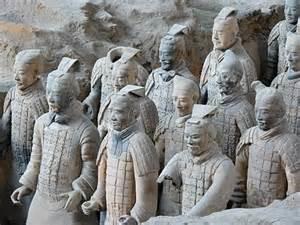
Flashback for a moment to ancient China. In 1974, farmers in the Shaanxi province discovered the now-famous Terracotta Army, which is said to have three pits containing 8,000 soldiers. China’s Xi’an Terracotta Army, which was funerary art (art related to buried remains) depicting the army of China’s First Emperor during the late 3rd century BCE. Well, Lund put its own spin on this remarkable discovery in China. The Lund display captures over 140 visitors (including children) in a 3D scanned and printed bust display that is quite a sight to behold. (Now if only they would bury the busts for future generations to discover!)
What prompted this idea is a desire to participate by displaying 3D technologies in Lund’s Kulturnatten. During Kulturnatten, individual heads were 3D scanned to make mini-me busts, and some were printed during the course of the day, but the bulk of them were printed in nylon with the University’s new Selective Laser Sintering (SLS) system. While the Xi’an warriors were formed out of terracotta, this project relied on a new and common 3D printing material instead: nylon.
Using design software, the busts were made to be 6 cm tall, and many were printed at one time. The scan files were “nested together” for printing and each bust has the individual’s name underneath. (If only we could say the same for all of those Chinese terracotta warriors!) The results are pretty cool. Like the Terracotta Army, the display is interesting as each individual figure comes to be a mere part of the larger whole.
Projects like this are excellent ways to educate the public not only about 3D printing technology but about the historical role that statues/ figures have played as commemorative elements of ancient societies. It’s amazing to think that the Terracotta Army was discovered as recent as 1974. While 3D printing encourages us to get prepared for the future, it can also prompt us to reflect more deeply on past societies and the technologies used to create the kind of wonder that the Terracotta Army represents.
Discuss this story in the Terracotta Army forum thread on 3DPB.com.